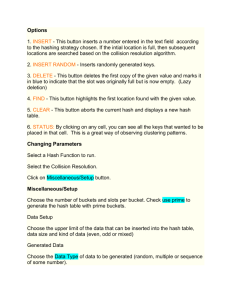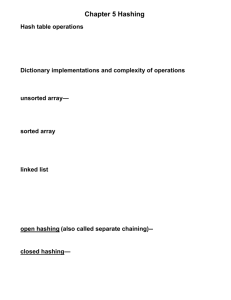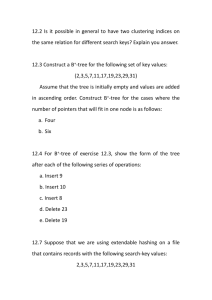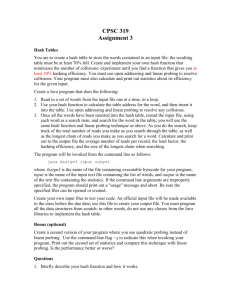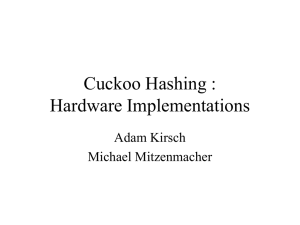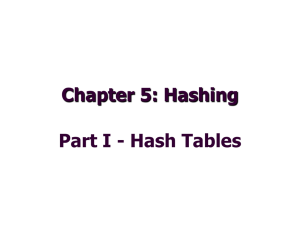Weeks 6 and 7 summary
advertisement
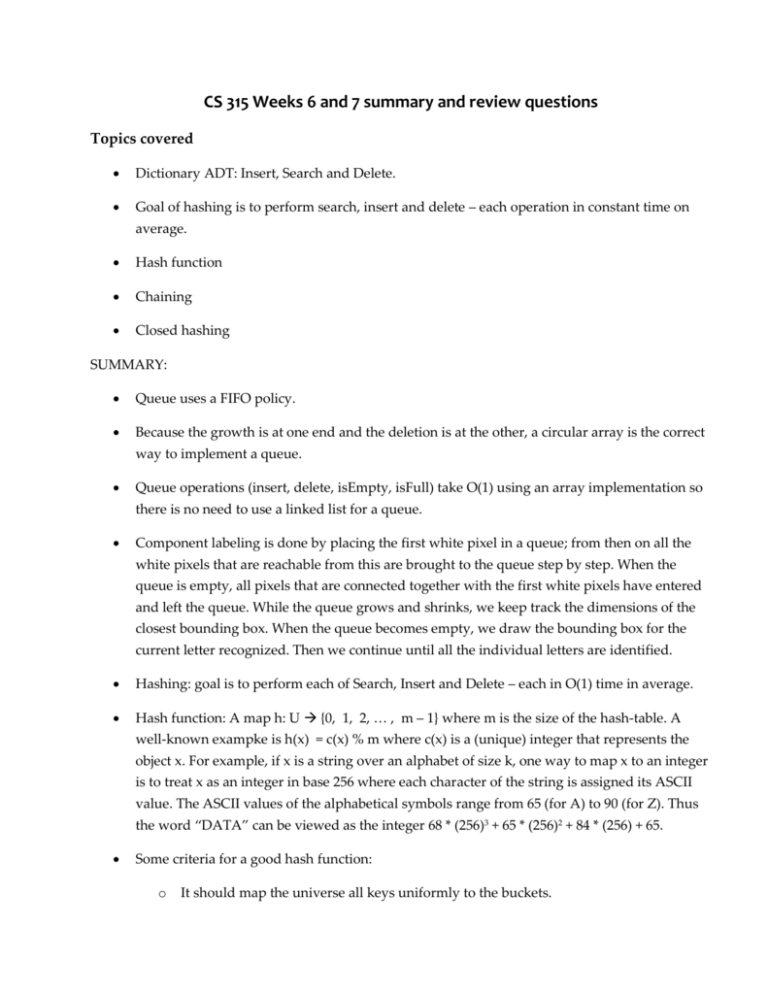
CS 315 Weeks 6 and 7 summary and review questions
Topics covered
Dictionary ADT: Insert, Search and Delete.
Goal of hashing is to perform search, insert and delete – each operation in constant time on
average.
Hash function
Chaining
Closed hashing
SUMMARY:
Queue uses a FIFO policy.
Because the growth is at one end and the deletion is at the other, a circular array is the correct
way to implement a queue.
Queue operations (insert, delete, isEmpty, isFull) take O(1) using an array implementation so
there is no need to use a linked list for a queue.
Component labeling is done by placing the first white pixel in a queue; from then on all the
white pixels that are reachable from this are brought to the queue step by step. When the
queue is empty, all pixels that are connected together with the first white pixels have entered
and left the queue. While the queue grows and shrinks, we keep track the dimensions of the
closest bounding box. When the queue becomes empty, we draw the bounding box for the
current letter recognized. Then we continue until all the individual letters are identified.
Hashing: goal is to perform each of Search, Insert and Delete – each in O(1) time in average.
Hash function: A map h: U {0, 1, 2, … , m – 1} where m is the size of the hash-table. A
well-known exampke is h(x) = c(x) % m where c(x) is a (unique) integer that represents the
object x. For example, if x is a string over an alphabet of size k, one way to map x to an integer
is to treat x as an integer in base 256 where each character of the string is assigned its ASCII
value. The ASCII values of the alphabetical symbols range from 65 (for A) to 90 (for Z). Thus
the word “DATA” can be viewed as the integer 68 * (256)3 + 65 * (256)2 + 84 * (256) + 65.
Some criteria for a good hash function:
o
It should map the universe all keys uniformly to the buckets.
o
It should use all the digits of the key.
o
It should be easy to compute.
The hash table size is desirable to be a prime number.
Load factor = n /m where m = number of buckets in the hash table and n = the number of
keys currently in the table.
Chaining: keys that map the same location are chained to form a linked list.
o
Complexity of unsuccessful search ~
o
Complexity of successful search ~ / 2
Closed hashing: the keys are directly stored in the table. Need policy for rehashing in case of
collisions.
o
Linear probing
o
Linear probing with increment d > 1
o
Quadratic probing
o
Double hashing
o
Random hashing
Assuming random hashing, the complexity of unsuccessful search is ~ 1/ ( 1 – )
Review questions:
5.1, 5.2, 5.5
4) Consider the chaining based hash table. Suppose the hash table currently contains the keys 23,
8, 41, 33, 34, 19, 12. Assume also that U = {1, 2,…, 40} and that the hash function used is h(x) =
x mod 11. (a) if one of the current keys in the table is being searched with uniform probability,
what is the expected number of comparisons performed? (b) if one of the keys currently not in
the table is being inserted into the table (again from uniform distribution), what is the
expected number of comparisons performed? (Note that the insertion algorithm searches the
list h(x) before inserting the key x.)
5) Answer (3) assuming that the closed hashing is used. Assume that the rehashing strategy used
is linear probing with increment d = 1.
6) Consider a spelling checker application in which the size of the dictionary is ~ 105. Suppose
the document on which spelling check is performed has about 104 distinct words. Answer the
following questions for (1) chaining based hash table and (2) closed hashing with linear
probing. (Assume that the table size chosen is 2 x 105.)
a. What is the expected number of operations performed to search the words?
b. What is the expected number of operations performed to insert words from the
dictionary at the start and near the end of insertion process?
7) What is the successive sequence of indices probed while searching for the key x with h(x) = 10
on a hash table of size 17 (a) in the case of linear probing with d = 3 and (d) in the case of
quadratic probing and (c) in the case of secondary hashing assuming g(x) = 7. (g(x) is the
secondary hash function.)





